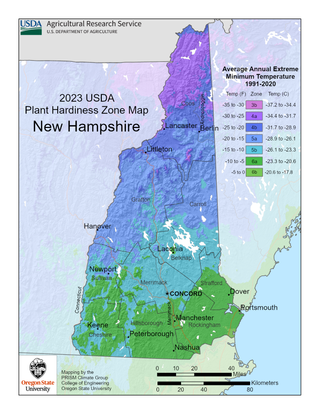New Hampshire Planting Zones - USDA Map Of New Hampshire Growing Zones

Click on the image above to see a larger version.
Learning About the USDA Plant Hardiness Zones in New Hampshire
New Hampshire can have cold winters, down to -35 degrees F. (-37 C.) in some parts. The New Hampshire USDA planting map divides this northerly state into six zones: 3b, 4a, 4b, 5a, 5b, 6a, and 6b.
At the end of 2023, the USDA released a new plant hardiness zone map that was the product of 30 years of data collection from all over the country. Zones are categorized based on several factors with the most weight going toward extreme average winter low temperatures.
Other factors that have been taken into consideration are elevation, urban heat, and proximity to a large body of water. Although things like humidity, winter sunshine, soil moisture, and duration exposed to cold temperatures are not factored in, it is wise for any gardener to start with the USDA planting zones.
The majority of the New Hampshire planting zones experience extremely cold winters with chilly lows; however, many flowers, shrubs, and trees can survive and thrive in this climate. It is always best to choose native species that are well adapted to specific growing regions and weather extremes.
Reputable nurseries in your area will only carry plants that are clearly marked with the USDA planting zones that are appropriate for the plant that is for sale. While the USDA New Hampshire zone map sets the standard for winter hardiness, it is not fool proof. Failing to properly plant or care for a flower, tree, or shrub or a freak weather occurrence, such as uncommonly cold or warm temperatures, can injure or kill plants. Use the New Hampshire planting map as a guide but always be aware of other variables.
Gardening tips, videos, info and more delivered right to your inbox!
Sign up for the Gardening Know How newsletter today and receive a free download of our most popular eBook "How to Grow Delicious Tomatoes."
-
 How To Grow Garden To Table: A Guide For Home Cooks
How To Grow Garden To Table: A Guide For Home CooksWhat could be better than a meal that comes directly from garden to table? Show off your gardening and culinary skills with the very freshest food.
By Bonnie L. Grant
-
 Want a Backyard Mini Orchard? Create Your Own Container Orchard
Want a Backyard Mini Orchard? Create Your Own Container OrchardEasier to care for in small spaces, a backyard mini-orchard makes sense for busy gardeners and juicy fruit is the reward.
By Teo Spengler